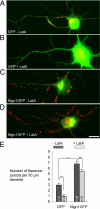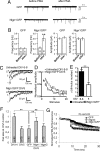Postsynaptic Neuroligin1 regulates presynaptic maturation
- PMID: 19628693
- PMCID: PMC2726414
- DOI: 10.1073/pnas.0905819106
Postsynaptic Neuroligin1 regulates presynaptic maturation
Abstract
Presynaptic nerve terminals pass through distinct stages of maturation after their initial assembly. Here we show that the postsynaptic cell adhesion molecule Neuroligin1 regulates key steps of presynaptic maturation. Presynaptic terminals from Neuroligin1-knockout mice remain structurally and functionally immature with respect to active zone stability and synaptic vesicle pool size, as analyzed in cultured hippocampal neurons. Conversely, overexpression of Neuroligin1 in immature neurons, that is within the first 5 days after plating, induced the formation of presynaptic boutons that had hallmarks of mature boutons. In particular, Neuroligin1 enhanced the size of the pool of recycling synaptic vesicles, the rate of synaptic vesicle exocytosis, the fraction of boutons responding to depolarization, as well as the responsiveness of the presynaptic release machinery to phorbol ester stimulation. Moreover, Neuroligin1 induced the formation of active zones that remained stable in the absence of F-actin, another hallmark of advanced maturation. Acquisition of F-actin independence of the active zone marker Bassoon during culture development or induced via overexpression of Neuroligin1 was activity-dependent. The extracellular domain of Neuroligin1 was sufficient to induce assembly of functional presynaptic terminals, while the intracellular domain was required for terminal maturation. These data show that induction of presynaptic terminal assembly and maturation involve mechanistically distinct actions of Neuroligins, and that Neuroligin1 is essential for presynaptic terminal maturation.
Conflict of interest statement
The authors declare no conflict of interest.
Figures





References
Publication types
MeSH terms
Substances
LinkOut - more resources
Full Text Sources
Molecular Biology Databases

